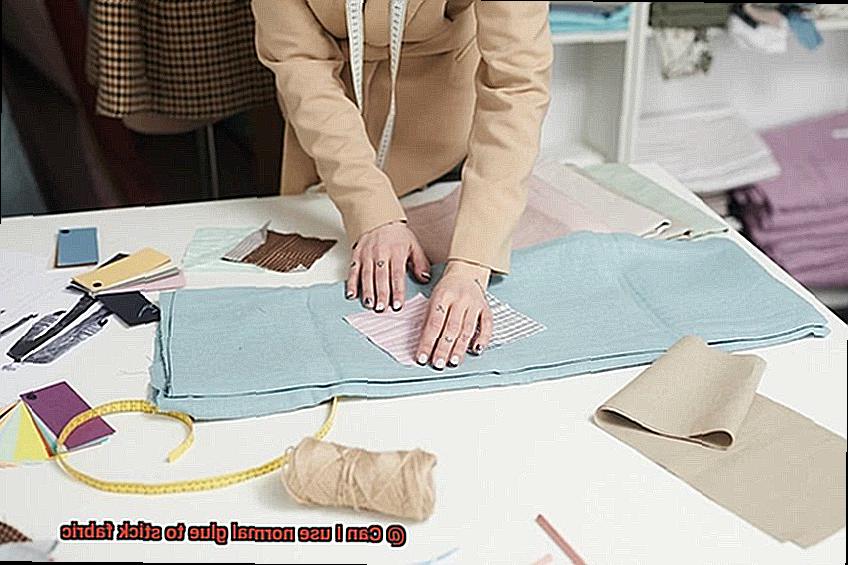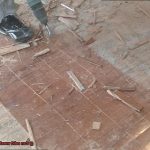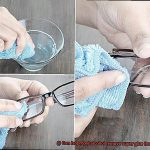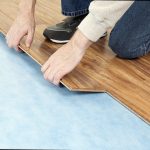Are you excited about starting a DIY project that involves sticking fabric pieces together? But wait, which adhesive should you use? With so many options available, it can be overwhelming to choose the right one. You might be tempted to use normal glue as a simpler and more cost-effective solution. However, can it really get the job done?
In this blog post, we’ll take a deep dive into the world of glues and fabrics to answer this question once and for all. We’ll explore the different types of glue available and whether they’re suitable for fabric. Additionally, we’ll discuss the potential consequences of using regular glue instead of fabric glue.
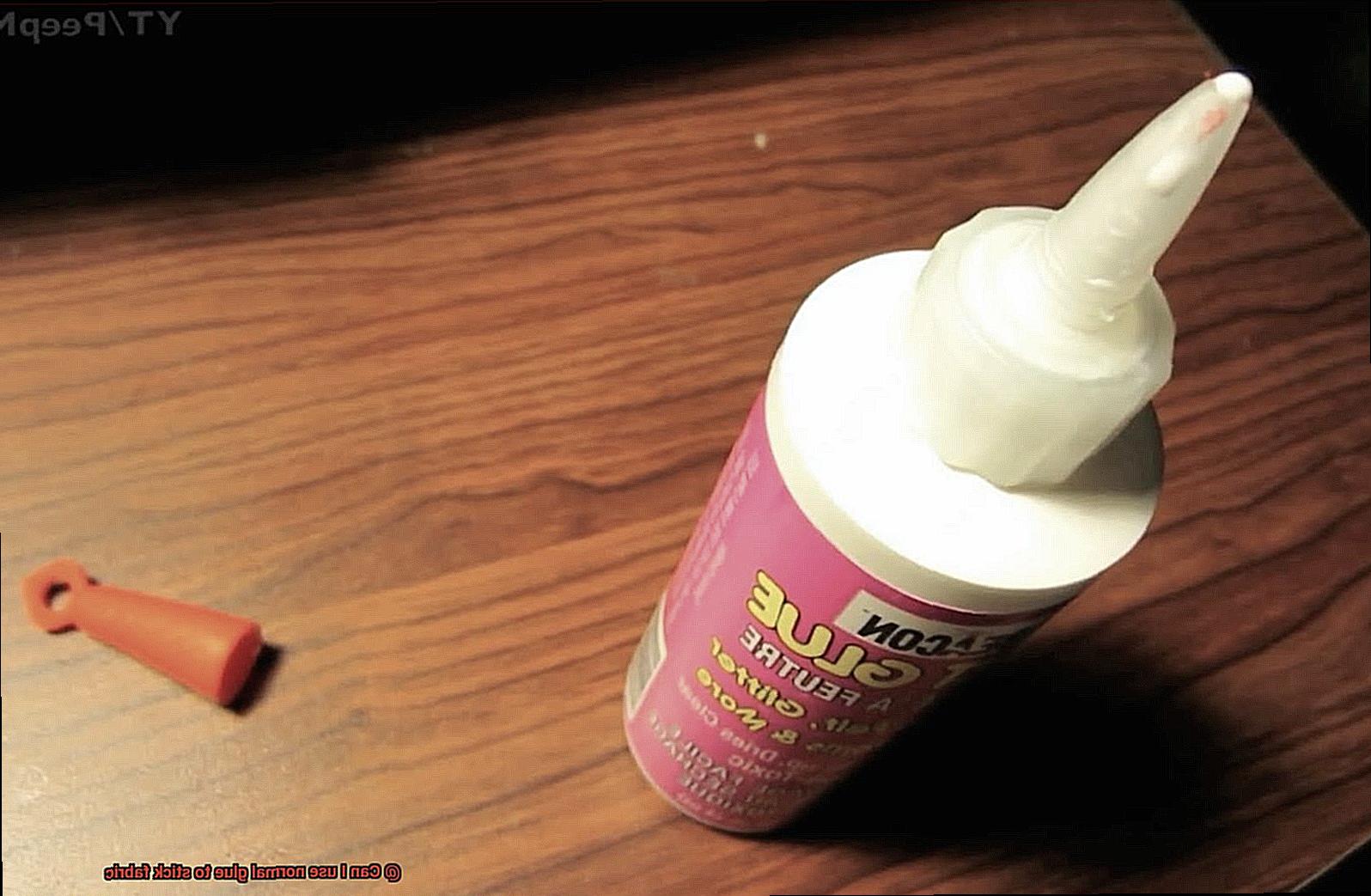
As you continue reading, you’ll discover that choosing the right glue depends heavily on the type of fabric you’re working with and your project’s purpose. Furthermore, you’ll learn about the benefits of using a fabric-specific adhesive and how it can ensure a long-lasting bond between your fabric pieces.
So if you’re eager to learn the truth about using normal glue on fabric, buckle up and read on.
What is Normal Glue?
Contents
But what exactly is it made of, and what materials can it bond together?
Normal glue is made from polyvinyl acetate, a synthetic polymer that is water-soluble and dries clear. This versatile adhesive can bond a variety of materials together, including paper, cardboard, wood, and some plastics. However, when it comes to fabrics, normal glue may not be the best option due to its lack of strength and flexibility.
If you’re looking to bond fabrics together, it’s recommended to use a fabric-specific adhesive or a solvent-based adhesive that has a stronger hold. These adhesives are designed to withstand washing and wear, ensuring a long-lasting hold.
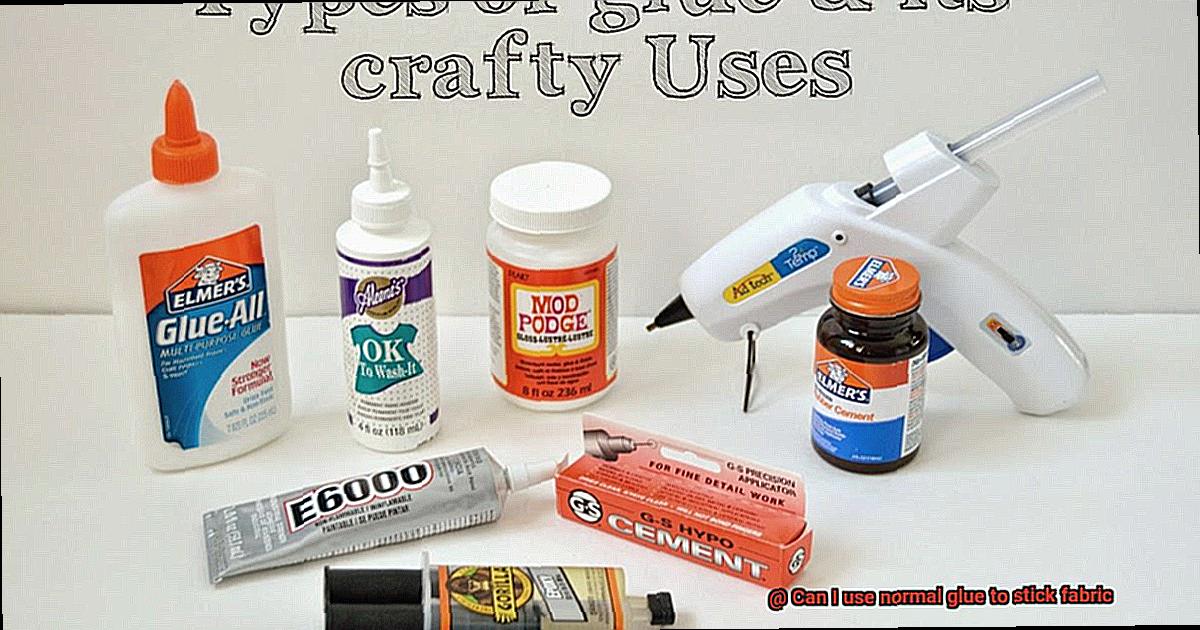
But if you need to use normal glue for a temporary fix on fabric, here are some tips to increase its effectiveness. First, make sure the fabric is clean and dry before applying the glue. Then, apply a thin layer of glue to one surface and press the two surfaces firmly together. Allow the glue to dry completely before handling the fabric.
It’s important to note that using normal glue on certain types of fabric, such as silk or wool, may result in damage or discoloration. Always test a small area before applying any adhesive to the entire surface.
Advantages of Using Normal Glue
Firstly, normal glue is easily accessible and available at any hardware or craft store. This makes it a convenient option for those who need an adhesive solution without having to go out of their way to find specialty glue. You don’t have to spend hours searching for the right adhesive when normal glue is readily available.
Secondly, normal glue dries clear, making it perfect for use on light-colored or sheer fabrics. Unlike other adhesives like tape or hot glue, normal glue won’t show through your fabric. This makes it ideal for use on clothing or other fabric items that require a seamless finish. You can achieve a professional-looking result without worrying about the adhesive showing through.
Thirdly, normal glue is versatile and can be used on a variety of fabric types, including cotton, polyester, and even silk. It works well on both thin and thick fabrics, making it a great choice for a wide range of projects. You don’t have to worry about finding different types of glue for different types of fabrics – normal glue can handle them all.
Lastly, normal glue can be easily washed out of fabrics. This makes it an ideal choice for temporary fixes or projects that require adjustments. Additionally, it can be used in combination with other sewing techniques like stitching or hemming to reinforce the hold and ensure longevity. You don’t have to worry about damaging your fabric or ruining your project if you need to make any changes.
Disadvantages of Using Normal Glue
Before reaching for the normal glue, it’s important to consider the many disadvantages that come with using it.
One of the biggest downsides of using normal glue on fabric is that it can cause long-term damage or discoloration. The chemicals in the glue can break down the fibers of the fabric, causing it to weaken and lose its original color over time.
Moreover, normal glue is not flexible, which means that any stretching or movement can cause it to crack and break apart. This is especially problematic for fabrics that need frequent washing or wearing, as the constant motion can quickly cause the glue to deteriorate.
In addition to being inflexible, normal glue is also notoriously messy and challenging to work with. It can easily get on other surfaces, leaving behind a frustratingly sticky residue that is difficult to remove. This can be particularly frustrating when working with delicate fabrics that cannot be easily replaced.
Lastly, normal glue is not designed to withstand exposure to moisture or heat. If the glued fabric comes into contact with water or high temperatures, the glue can easily dissolve or melt, causing the bond to break.
Alternatives to Normal Glue
There are plenty of alternatives to normal glue that can give you long-lasting and durable outcomes for all your fabric needs. Let’s delve into some of the most popular options available:
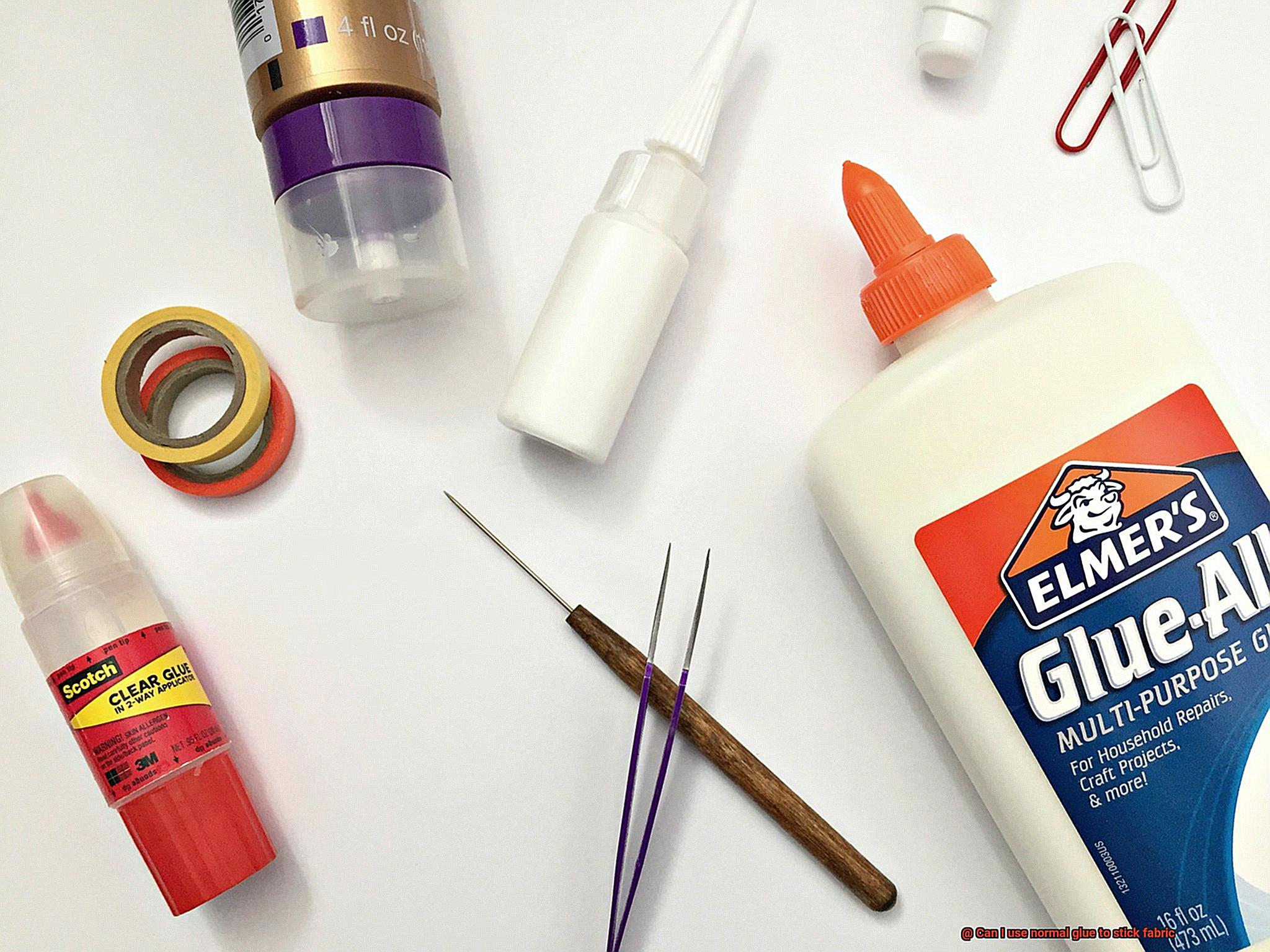
Fabric Glue
This specialized glue is tailor-made for fabrics and is readily available in most craft stores. What sets fabric glue apart is its clear-drying and flexible properties, making it an excellent choice for those who want to avoid using traditional glue.
Fusible Webbing
Also known as iron-on adhesive, this thin layer of adhesive can be activated with heat from an iron, which allows it to bond to fabric. Fusible webbing is commonly used for hemming and repairing garments and can be found in most sewing supply stores.
Double-Sided Tape
This type of tape has adhesive on both sides and can be used to temporarily hold fabric in place before sewing or permanently adhering it with another method. Double-sided tape is user-friendly and is readily available at most hardware stores.
Spray Adhesives
These adhesives are created specifically for use with fabrics and offer a quick and easy application without the mess that comes with traditional glue. However, it is vital to use spray adhesives in a well-ventilated area and to follow the manufacturer’s instructions carefully.
Each option comes with its own set of advantages and disadvantages, so it’s important to choose the right one based on your specific needs and preferences. With these alternatives to normal glue, you can confidently stick your fabrics with ease.
Tips for Improving the Effectiveness of Normal Glue
Normal glue can be a great option. However, to achieve the best results, you need to follow some tips and tricks to make it more effective.
The first step is to ensure that the fabric and surface are clean before applying the glue. Dirt, dust, or other debris can prevent the glue from adhering to the fabric properly. So, wash the fabric with mild soap and water, then allow it to dry completely before applying the glue.
It’s also vital to use a thin layer of glue. Applying too much glue can make it difficult for the fabric to bond correctly, weakening the bond between the fabric and adhesive. Spread it out evenly with a brush or applicator to ensure full coverage.
Once the glue is applied, let it dry completely before handling or moving the fabric. This may take several hours or even overnight, depending on the type of glue used. Don’t rush this process. The longer it dries, the stronger and long-lasting the bond will be.
For an extra-strong hold, use a pressing tool like an iron or heavy book to apply pressure on the glued area. This will help create a tight seal between the two materials and ensure a strong bond.
Finally, consider using specialized fabric glue for a more durable hold. These types of adhesives are designed specifically for fabrics and can withstand washing and wear.
Considerations When Using Normal Glue on Certain Fabrics

Great. Before you dive in, there are some key considerations to keep in mind. Not all fabrics are created equal, and certain types of glue may not work well with some fabrics.
First and foremost, consider the type of fabric you are using. Synthetic fabrics like polyester or nylon have a smooth texture and lack absorbency, which may make them less receptive to normal glue. Natural fibers such as cotton or wool may be more receptive to glue, but it’s still essential to select the right type of glue for the job.
Another factor to keep in mind is the purpose of your project. If your fabric will be washed or exposed to moisture, a waterproof or washable glue will be necessary to ensure a strong bond. Similarly, if your fabric will endure wear and tear or frequent use, you may need a stronger adhesive.
It’s also crucial to consider the color and texture of your fabric when selecting a glue. Certain glues may leave behind a visible residue or discoloration, which can detract from your project’s overall appearance. And delicate fabrics may require a gentle adhesive that won’t cause damage.
CpMhRyabggI” >
Conclusion
In conclusion, the question of whether or not normal glue can be used to stick fabric is a bit of a tricky one. While it may seem like an easy and cheap solution, using regular glue on fabric can actually have some serious drawbacks in terms of durability and appearance. Normal glue simply doesn’t have the strength and flexibility needed to stand up to washing and wear, which makes it a poor choice for any long-term projects.
Thankfully, there are plenty of alternatives available that are specifically designed for use with fabrics. From fabric glue to fusible webbing, double-sided tape, and spray adhesives, there are plenty of options out there that offer clear-drying and flexible properties that ensure a strong bond that will last.
Of course, if you do decide to use normal glue on fabric for a temporary fix or small project, there are ways to make it work better. For example, you’ll want to make sure that your fabric is clean and dry before applying the glue. You’ll also want to use a thin layer of glue applied evenly with an applicator or brush. Once you’ve applied the glue, be sure to let it dry completely before handling the fabric – and if you need extra hold, try applying pressure with an iron or heavy book.
Ultimately, choosing the right adhesive for your needs depends on several factors – including the type of fabric you’re using, your project’s purpose, as well as its color and texture.

